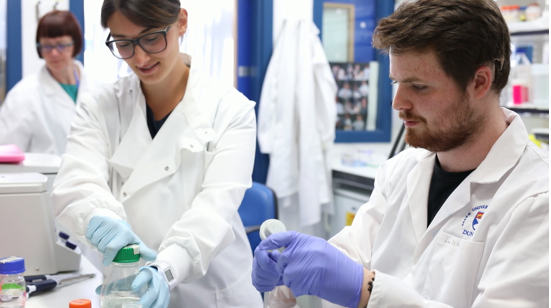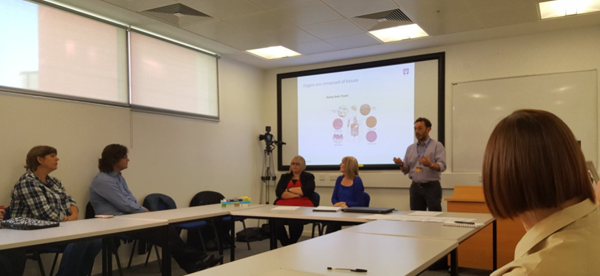BSDB Gurdon Summer Studentship Report (21)
Posted by BSDB, on 5 December 2017
![]() Established by the British Society for Developmental Biology in 2014, The Gurdon/The Company of Biologists Summer Studentship scheme provides financial support to allow highly motivated undergraduate students an opportunity to engage in practical research during their summer vacation. Each year, ten successful applicants spend eight weeks in the research laboratories of their choices, and the feedback we receive is outstanding.
Established by the British Society for Developmental Biology in 2014, The Gurdon/The Company of Biologists Summer Studentship scheme provides financial support to allow highly motivated undergraduate students an opportunity to engage in practical research during their summer vacation. Each year, ten successful applicants spend eight weeks in the research laboratories of their choices, and the feedback we receive is outstanding.
Our tenth report from the 2017 group of student awardees comes from Liam McMulkin (student at The University of Dundee), who undertook his studentship with Dr. Marios Stavridis and Dr. David Martin at The University of Dundee.
British Sign Language (BSL) is a form of sign language which involves in the use of hand movements, gestures, body language and facial expressions to communicate. BSL is mainly used by deaf people. Unfortunately, BSL usually does not have signs for technical words that are not normally used in daily conversations, in biology for example, adenosine triphosphate, centriole, ectotherm, and many more which consequently lead to deaf people not having an equal access to biology compared with hearing people e.g. Interpreters don’t have signs for biological terms, which results in the use of fingerspelling. However, fingerspelling can be a lengthy process as every letter has to be spelt and is therefore not appropriate for a biology lecture, and also it is unpleasant to watch. Could you imagine a lecturer speaking out individual letter to spell out a word, more than twenty times in an hour lecture? E.g. electrophoresis and electroporation. Sometimes it can be difficult to distinguish between two words in a same lecture e.g. pluripotent, totipotent etc. especially when they are spelt out one letter at a time.
Scottish Sensory Centre has National 4 Biology BSL glossary. Unfortunately, they cannot source more funding to expand their BSL glossary for biology. Therefore, I decided to do something. I want to change this, I want deaf people to have a better access to biology with a better standard of BSL. This is a good timing to change this, as now it is an exciting time to study biology as new technologies open up novel areas of discovery e.g. genetic engineering and stem cells. Deaf people deserve to learn in their first language.
Dr. Marios Stavridis and Dr. David Martin agreed to support me to change this. They persuaded me to apply for this fantastic BSDB Gurdon Summer Studentship. After a month of waiting, I was very pleased to find out my application turned out successful. Straight away, I was given an unrestricted access to the staff in the Division of Cell and Developmental Biology at the University of Dundee, also space in the building to use as my base and meet with staff and postgraduate students to develop this glossary. In the process, I gained a first-hand experience of topics in Developmental Biology spanning the areas from Evo-Devo, live imaging of gastrulation, stem cells, neural and mesoderm development. This allowed me to get a feel for the terms beyond a dictionary definition. BSL is a very visual language and imagery is important in making good terminology. I spent a month doing this, before I ran the workshops.
The workshops were held on 8th and 10th August at University of Dundee. I sent out invitations using BSL via a video on Facebook with closed captions. The video had many shares, and I think it has shocked some people as they never knew that BSL has a limited glossary. University of Dundee also released a video about my workshops, which has reached to many people. Other news agencies such as Times Higher Education also released a news piece about my project. I am pleased that my project was well informed to the public because it raises awareness about BSL and its glossary.
Over 15 BSL users (aged from 20 and 70) attended and took part in the process of developing signs. Dr. Marios Stavridis briefly introduced what Developmental Biology is. Then, a Ph.D student provided a talk about her research work – two BSL interpreters struggled translating the talk due to lack of complex signs. Before we started developing new signs, a BSL linguistic, Gary Quinn introduced how to develop signs, and ensure they follow BSL grammar. I prepared a PowerPoint with terms we lack signs in with definitions and other helpful resources. All the participants worked together really well and developed over 70 new signs! At the end of the last workshop, the Ph.D student repeated her talk, and the participants were extremely shocked how improved the translations were from the same interpreters.
After the workshops, I spent roughly three days signing the newly developed signs. I then shared the signs online via Facebook for review. The feedbacks I received were really positive.
Now, I am at the last stage before finishing the project. The developed signs are required to be reviewed by Scottish Sensory Centre Glossary Manager, Dr. Audrey Cameron and a BSL linguistic, Gary Quinn before they are uploaded online at Scottish Sensory Centre website.
I can’t express how much I appreciated everyone’s support in this project. I millions of times thank to BSDB for selecting me to part of their studentship programme. Also, millions of times thank to The Robertson Trust for covering the costs for running the 2-day workshops at University of Dundee. I thank all the participants for all their efforts in developing signs for complex terms. Thank you to Dr. Marios Stavridis for being my supervisor. Also, for arranging an unrestricted access to the College of Life Sciences which gave me unique experience meeting world-leading scientists and observed their real work. Many thanks to Dr. David Martin for co-supervising me, and allow me to borrow his high-quality filming devices. My filming skills have improved! Finally, many thanks to Francesca Carrieri for her time observing her work and her time to come along to my workshop to deliver a talk on her research work.
In conclusion, I am very pleased I took this opportunity to improve BSL vocabulary for biology, which will improve deaf people’s access to education and science-related workplaces. Also, general science conversations using BSL. From this project, I hope more funding bodies have recognised the work of Scottish Sensory Centre and support them expanding BSL vocabulary to help deaf students in education. Finally, I really hope this project encourages Scottish Sensory Centre to add more of university-level vocabulary rather than just school-level vocabulary for help deaf higher-education students like myself.




 (4 votes)
(4 votes)
I am proud of what Liam achieved over a very limited time. I know first hand that this summer’s efforts have already made a difference to his studies and hope that his efforts form a foundation to expand the glossary to further benefit BSL users and encourage more deaf students into Biology!